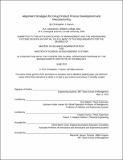| dc.contributor.advisor | Roy Welsch and Charles Cooney. | en_US |
| dc.contributor.author | Garvin, Christopher John | en_US |
| dc.contributor.other | Leaders for Global Operations Program. | en_US |
| dc.date.accessioned | 2012-09-27T15:27:29Z | |
| dc.date.available | 2012-09-27T15:27:29Z | |
| dc.date.copyright | 2012 | en_US |
| dc.date.issued | 2012 | en_US |
| dc.identifier.uri | http://hdl.handle.net/1721.1/73382 | |
| dc.description | Thesis (M.B.A.)--Massachusetts Institute of Technology, Sloan School of Management; and, (S.M.)--Massachusetts Institute of Technology, Engineering Systems Division; in conjunction with the Leaders for Global Operations Program at MIT, 2012. | en_US |
| dc.description | Cataloged from PDF version of thesis. | en_US |
| dc.description | Includes bibliographical references (p. 113-116). | en_US |
| dc.description.abstract | The transfer of information between the drug product development and manufacturing organizations is fundamental to drug product commercialization. This information is used to characterize the product-process interaction and ensure manufacturability, and to set operating ranges at fill/finish sites. Amgen has successfully commercialized drug products for years, yet opportunities exist to improve the efficiency of process development and technology transfer, and to better align the equipment, procedures, and data collection of the groups involved in these activities. We identify improvement opportunities and develop a strategic approach, which we term the "Pilot Plant Cooperative," to enable more efficient and effective commercialization. The benefits of this strategy are assessed in three case studies: (1) a capital investment project for new laboratory filling equipment, (2) enhanced data generation in clinical manufacturing, and (3) efficiency improvements in early-stage process development studies. Based on these studies, we make specific recommendations for future work. We make additional procedural and cultural recommendations, including revising capital investment processes and implementing alignment-focused incentives and hiring practices, to ensure widespread alignment is achieved and maintained. | en_US |
| dc.description.statementofresponsibility | by Christopher J. Garvin. | en_US |
| dc.format.extent | 130 p. | en_US |
| dc.language.iso | eng | en_US |
| dc.publisher | Massachusetts Institute of Technology | en_US |
| dc.rights | M.I.T. theses are protected by
copyright. They may be viewed from this source for any purpose, but
reproduction or distribution in any format is prohibited without written
permission. See provided URL for inquiries about permission. | en_US |
| dc.rights.uri | http://dspace.mit.edu/handle/1721.1/7582 | en_US |
| dc.subject | Sloan School of Management. | en_US |
| dc.subject | Engineering Systems Division. | en_US |
| dc.subject | Leaders for Global Operations Program. | en_US |
| dc.title | Alignment strategies for drug product process development and manufacturing | en_US |
| dc.type | Thesis | en_US |
| dc.description.degree | S.M. | en_US |
| dc.description.degree | M.B.A. | en_US |
| dc.contributor.department | Leaders for Global Operations Program at MIT | en_US |
| dc.contributor.department | Massachusetts Institute of Technology. Engineering Systems Division | |
| dc.contributor.department | Sloan School of Management | |
| dc.identifier.oclc | 809794716 | en_US |
